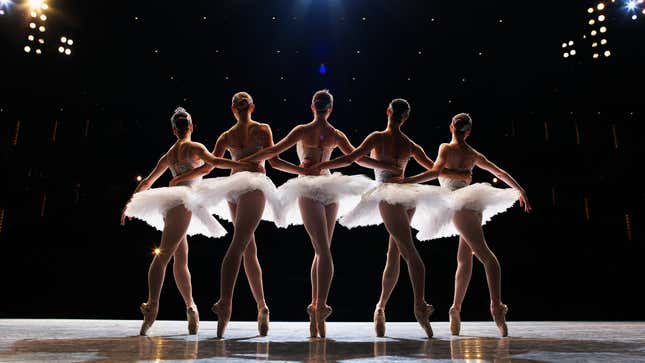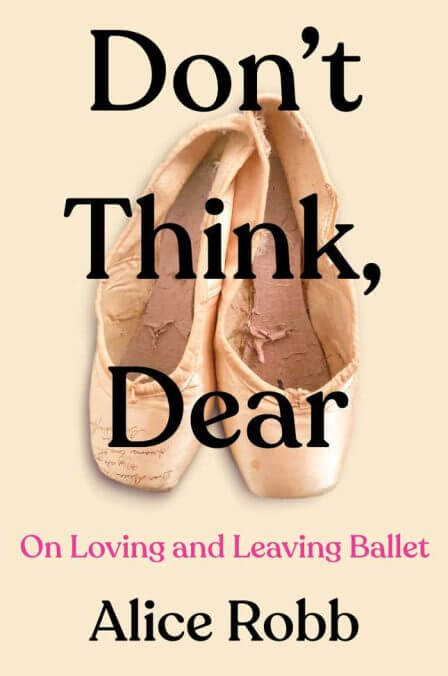In Ballet, Pain Really Is Beauty
"I wanted bunions, blisters, bleeding toenails, and I envied the girls who bruised more easily," Alice Robb writes in her book about being a child ballerina.
BooksEntertainment

The following is an excerpt from Don’t Think, Dear: On Loving and Leaving Ballet by Alice Robb, which came out on Tuesday. You can buy it at Bookshop and Amazon.
Throughout our lives, women suffer from all kinds of extra pain. We have more nerve receptors than men and, literally, thinner skin. In the lab, women exposed to the same electric shocks and hot and cold stimuli register more acute pain. From the time girls learn where babies come from, they anticipate the pain of giving birth. From puberty through middle age, women risk cramps, migraines, nausea, and muscle aches every month. Pain is often a facet of girls’ sexual initiation, and many just accept it. “The sex was always painful but I thought that perhaps that was the price of being loved,” the sex worker Liara Roux writes of her first romance. In a survey (described in the Journal of Sexual Medicine) of over 1700 men and women in the United States, 30 percent of women say they experienced pain the last time they had sex, compared with just 5 percent of men.
The most common response to all of this is to grit our teeth. In her memoir Sick, the writer Porochista Khakpour reflects on a lifetime of physical and mental anguish—and on how her identity as a person in pain has been intertwined with her identity as a woman. Growing up, she looked forward to getting her period—“the affliction that it seemed everyone I knew got to complain about.” When she fainted after emerging from a too-hot shower, at the age of 13, it felt, on some secret level, like a longed-for rite of passage, a fast-track ticket to fulfilling her gender identity. It was also, she wrote, “the first time I got to feel like a woman”—and the dawning of her realization “that perhaps ailment was a feature central to that experience.” Dainty and fragile, she felt like an ideal woman—“like a crystal ballerina.”
No one embraces pain more fully than dancers: the pain of contorting their bodies into impossible shapes—twisting the legs to turn outward from the hips; forcing the weight of the entire body onto the tip of one toe, then hopping up and down on that toe. The pain inherent in whittling their bodies into the toothpick figure [New York City Ballet choreographer George] Balanchine preferred.
But they suffer in silence. One of the first lessons dancers learn is to keep their expression pleasant no matter what: never to complain, even with their eyes. We learned to dissociate the look on our face from the ache in our feet, to always keep our expression regal, serene.

We looked up to women who danced through unbearable pain, who ignored life-threatening injuries. We learned about the Russian ballerina Anna Pavlova, who, in 1931, died of pneumonia in a Dutch hotel, refusing to undergo an operation that might have left her with a less-than-perfect body. Her stamina was Herculean. She assembled her own troupe in 1910, trekking all over Latin America, Asia, Australia, and Africa on crowded trains and dirty boats. She and her band of dancers, stagehands, and musicians got ready in dressing rooms flooded with sewage and performed on makeshift stages in churches and schools. They sailed to Ecuador on a cattle boat and danced in 102-degree heat. Pavlova was almost 50 when she died, and was still traveling and performing at a relentless pace; she was only on the first leg of a planned transatlantic tour when she ran a fever so high she was finally forced to lie down. We learned her apocryphal last words—“Get my Swan costume ready.”
Almost no one who saw Pavlova dance is still alive, and the footage that survives is scratchy and faint. I grew up hearing her name mentioned in reverent tones, but when I watched the clips recently, I was underwhelmed. Frilly costumes obscure half of her body. Her extensions are low; her feet are virtually flat. Her technique could be bested by any 12-year-old at Youth America Grand Prix. It’s not for the memory of her dancing but her willingness to suffer that her legend endures.
The threat of serious injury lurked behind every step, but it was the garden-variety pains that preoccupied us: blisters, sore muscles, bruised toes. And our daily dose of pain soared when we began dancing on pointe at 10 or 11.
My ballet classmates and I were, in almost every way, extremely obedient. But there was one rule many of us violated: before our teachers had deemed our feet strong enough, we went to Capezio or Bloch and got fitted for our first pointe shoes. We couldn’t wait.
I don’t remember buying my first bra or trying my first drink, but I remember the thrill of easing my feet into pointe shoes for the first time; of learning how to crisscross the ribbons over my ankles and tuck in the knot so it didn’t show—it might cut into my ankle, but at least it wouldn’t disturb the smooth line of my leg. I remember how elegant it looked and how the pain, when I stood up, was shocking. I would perform this ritual countless times in the coming years, but I would never get used to it; the pain was fresh every time.
I wanted bunions, blisters, bleeding toenails, and I envied the girls who bruised more easily. If my feet looked whole, I felt like a fraud. As Toni Bentley wrote in the New York Times: “A bloodied toe inside her first pair of toe shoes is a welcome symbol of initiation for a young ballerina, just as it is considered a sign of good luck for a professional.”
Excerpted from the book Don’t Think Dear: On Loving and Leaving Ballet by Alice Robb. Copyright © 2023 by Alice Robb. From Mariner Books, an imprint of HarperCollins Publishers. Reprinted by permission.